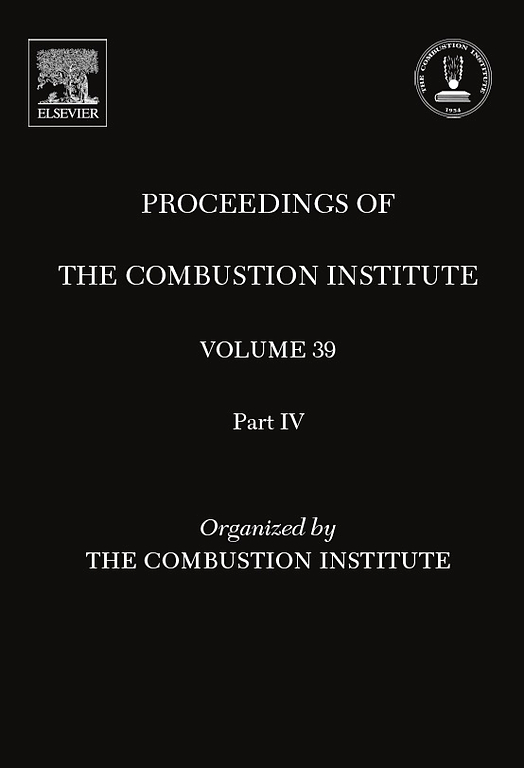Deepening the knowledge of carbon particulate matter features in the BSS flame configuration
IF 5.3
2区 工程技术
Q2 ENERGY & FUELS
引用次数: 0
Abstract
The paper reports a detailed study on carbon particulate matter (PM) sampled in ethylene flames stabilized on a burner-stabilized stagnation (BSS) system, aiming to give more insights on the characteristics of particles produced in this peculiar flame configuration. The study employs various diagnostic tools to analyze PM collected on the stagnation plate of flames at a constant equivalence ratio (Φ =2.07) and different flame temperatures obtained by varying the cold gas flow velocity. The carbon network of PM was analyzed by Raman and UV–Visible spectroscopy verifying the strong temperature effect on the nanostructure. The FTIR analysis allowed to quantitatively follow the temperature effect on the aromatic and aliphatic CH bonds, also evaluating the H/C atomic ratio that was found to be rather high (ranging from 0.3 to 0.5) initially decreasing and finally re-increasing as the flame temperature rises. The initial hydrogen loss with the rise of temperature was due to the loss of aromatic hydrogen, followed at higher temperature by the relevant enrichment of hydrogen bonded to aliphatic carbon. This observation is in contradiction with the expectation that higher flame temperatures would lead to an enhanced dehydrogenation of carbon particles, thereby reducing also aliphatic hydrogen. It was suggested that the enrichment in aliphatic hydrogen could be due to the small size of particles having higher radical character and surface area. Indeed, the peculiar features of such carbon particles deserve further work for understanding soot formation and growth and the relevance of BSS carbon material for optical and electronic applications.加深对 BSS 火焰配置中碳微粒物质特征的了解
本文报告了对在燃烧器稳定停滞(BSS)系统上稳定的乙烯火焰中取样的碳微粒物质(PM)进行的详细研究,旨在深入了解这种特殊火焰结构中产生的微粒特征。研究采用了各种诊断工具,分析在恒定当量比(Φ =2.07)和通过改变冷气体流速获得的不同火焰温度条件下火焰停滞板上收集的可吸入颗粒物。拉曼光谱和紫外可见光谱分析了 PM 的碳网络,验证了温度对纳米结构的强烈影响。傅立叶变换红外光谱分析可定量跟踪温度对芳香族和脂肪族 CH 键的影响,还可评估 H/C 原子比,发现该原子比相当高(从 0.3 到 0.5 不等),最初随着火焰温度的升高而降低,最后又重新升高。随着温度的升高,最初的氢损失是由于芳香族氢的损失,随后在更高的温度下,与脂肪族碳键合的氢得到了相应的富集。这一观察结果与人们的预期相矛盾,即火焰温度升高会导致碳颗粒的脱氢作用增强,从而也会减少脂肪族氢。有人认为,脂肪族氢的富集可能是由于具有较高自由基特性和表面积的小颗粒造成的。事实上,这种碳颗粒的特殊性值得进一步研究,以了解烟尘的形成和生长以及 BSS 碳材料在光学和电子应用中的相关性。
本文章由计算机程序翻译,如有差异,请以英文原文为准。
求助全文
约1分钟内获得全文
求助全文
来源期刊

Proceedings of the Combustion Institute
工程技术-工程:化工
CiteScore
7.00
自引率
0.00%
发文量
420
审稿时长
3.0 months
期刊介绍:
The Proceedings of the Combustion Institute contains forefront contributions in fundamentals and applications of combustion science. For more than 50 years, the Combustion Institute has served as the peak international society for dissemination of scientific and technical research in the combustion field. In addition to author submissions, the Proceedings of the Combustion Institute includes the Institute''s prestigious invited strategic and topical reviews that represent indispensable resources for emergent research in the field. All papers are subjected to rigorous peer review.
Research papers and invited topical reviews; Reaction Kinetics; Soot, PAH, and other large molecules; Diagnostics; Laminar Flames; Turbulent Flames; Heterogeneous Combustion; Spray and Droplet Combustion; Detonations, Explosions & Supersonic Combustion; Fire Research; Stationary Combustion Systems; IC Engine and Gas Turbine Combustion; New Technology Concepts
The electronic version of Proceedings of the Combustion Institute contains supplemental material such as reaction mechanisms, illustrating movies, and other data.
 求助内容:
求助内容: 应助结果提醒方式:
应助结果提醒方式:


